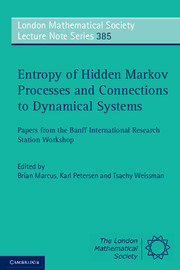 Entropy of Hidden Markov Processes and Connections to Dynamical Systems
Entropy of Hidden Markov Processes and Connections to Dynamical Systems Book contents
- Frontmatter
- Contents
- Introduction
- 1 Hidden Markov processes in the context of symbolic dynamics
- 2 On the preservation of Gibbsianness under symbol amalgamation
- 3 A note on a complex Hilbert metric with application to domain of analyticity for entropy rate of hidden Markov processes
- 4 Bounds on the entropy rate of binary hidden Markov processes
- 5 Entropy rate for hidden Markov chains with rare transitions
- 6 The capacity of finite-state channels in the high-noise regime
- 7 Computing entropy rates for hidden Markov processes
- 8 Factors of Gibbs measures for full shifts
- 9 Thermodynamics of hidden Markov processes
2 - On the preservation of Gibbsianness under symbol amalgamation
Published online by Cambridge University Press: 05 June 2011
- Frontmatter
- Contents
- Introduction
- 1 Hidden Markov processes in the context of symbolic dynamics
- 2 On the preservation of Gibbsianness under symbol amalgamation
- 3 A note on a complex Hilbert metric with application to domain of analyticity for entropy rate of hidden Markov processes
- 4 Bounds on the entropy rate of binary hidden Markov processes
- 5 Entropy rate for hidden Markov chains with rare transitions
- 6 The capacity of finite-state channels in the high-noise regime
- 7 Computing entropy rates for hidden Markov processes
- 8 Factors of Gibbs measures for full shifts
- 9 Thermodynamics of hidden Markov processes
Summary
Abstract. Starting from the full shift on a finite alphabet A, by mingling some symbols of A, we obtain a new full shift on a smaller alphabet B. This amalgamation defines a factor map from (Aℕ,TA) to (Bℕ, TB), where TA and TB are the respective shift maps. According to the thermodynamic formalism, to each regular function (“potential”) ψ:Aℕ → ℝ, we can associate a unique Gibbs measure µψ. In this article, we prove that, for a large class of potentials, the pushforward measure µψ ∘ π−1 is still Gibbsian for a potential φ:Bℕ→ℝ having a “bit less” regularity than ψ. In the special case where ψ is a “two-symbol” potential, the Gibbs measure µψ is nothing but a Markov measure and the amalgamation π defines a hidden Markov chain. In this particular case, our theorem can be recast by saying that a hidden Markov chain is a Gibbs measure (for a Hölder potential).
Introduction
From different viewpoints and under different names, the so-called hidden Markov measures have received a lot of attention in the last fifty years [3]. One considers a (stationary) Markov chain (Xn)n∈ℕ with finite state space A and looks at its “instantaneous” image Yn ≔ π(Xn), where the map π is an amalgamation of the elements of A yielding a smaller state space, say B. It is well known that in general the resulting chain, (Yn)n∈ℕ, has infinite memory.
- Type
- Chapter
- Information
- Entropy of Hidden Markov Processes and Connections to Dynamical SystemsPapers from the Banff International Research Station Workshop, pp. 72 - 97Publisher: Cambridge University PressPrint publication year: 2011
- 15
- Cited by
